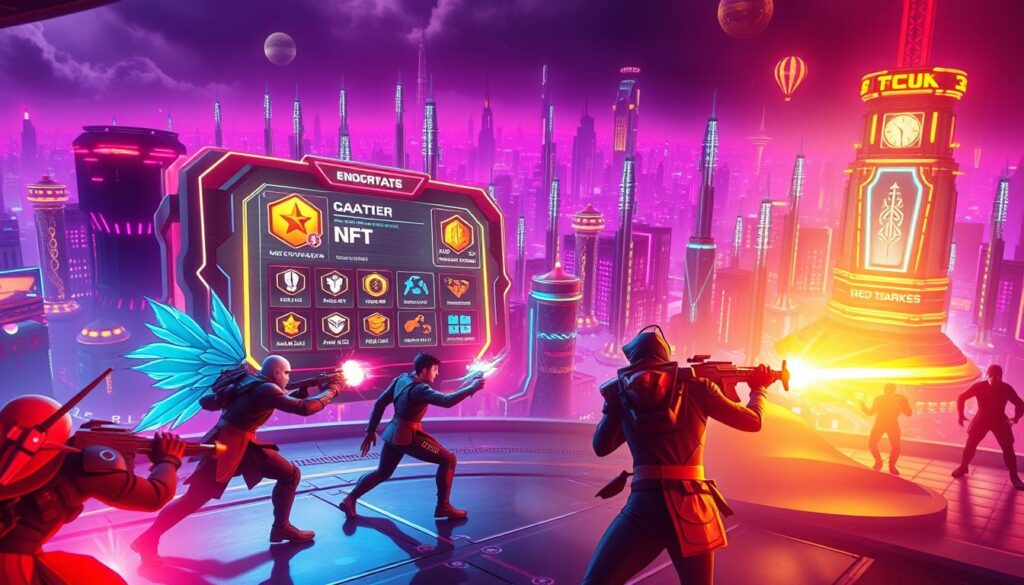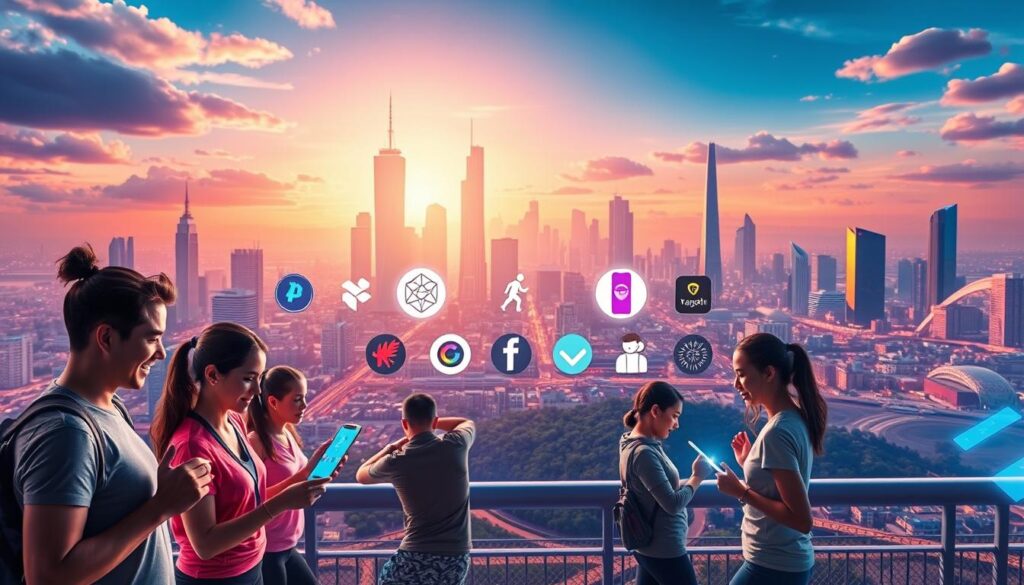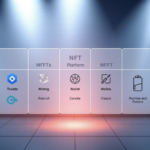Now Reading: Elevate Customer Loyalty with Innovative NFT Rewards
- 01
Elevate Customer Loyalty with Innovative NFT Rewards
Elevate Customer Loyalty with Innovative NFT Rewards

Traditional reward systems are evolving. Businesses now use unique digital tokens to create memorable experiences for their audiences. These tools go beyond basic discounts, offering verifiable ownership and lasting value through blockchain technology.
Imagine giving customers something they can truly own – not just points that vanish. Digital collectibles let brands design rewards with distinct traits, from limited-edition artwork to interactive experiences. This approach turns routine interactions into meaningful moments.
Industries like fashion and entertainment already use these strategies. A sports brand might release seasonal designs tied to real-world events. A streaming service could offer behind-the-scenes content as tradable assets. The possibilities grow as technology advances.
Unlike temporary perks, these digital rewards hold potential for value growth. Customers become invested in both the brand and their collection. This dual benefit strengthens relationships while opening doors to cross-industry partnerships.
Key Takeaways
- Digital collectibles replace generic rewards with unique, blockchain-verified assets
- Blockchain ensures transparent reward tracking and prevents duplication
- Rewards maintain value over time, sometimes increasing through scarcity
- Brands can collaborate across industries for shared reward ecosystems
- Interactive elements appeal to tech-savvy consumers seeking authentic experiences
The Evolution of Loyalty Programs in the Digital Age
Customer retention methods have shifted from punch cards to personalized digital ecosystems. Where paper-based systems once dominated, brands now leverage interactive platforms to deepen connections. This transformation reflects changing consumer demands for meaningful engagement over transactional exchanges.

Traditional Strategies vs. Digital Innovation
Early retention efforts focused on simple point collection. Customers earned stamps or credits for purchases, with rewards often limited to discounts. These systems struggled to create emotional bonds – 67% of consumers abandoned such static programs within a year.
Smartphones changed the game. Brands began integrating location-based offers and social sharing features. A coffee chain might send surprise rewards when users pass their stores. A beauty brand could unlock tutorials after five purchases. These tactics increased participation by 40% in early adopters.
Adapting to Changing Customer Expectations
Today’s consumers want rewards that mirror their digital lifestyles. Limited-edition virtual collectibles outperform generic coupons among Gen Z audiences. One athletic company saw 300% higher redemption rates when replacing cashback offers with exclusive workout content.
Artificial intelligence enables real-time personalization. Systems analyze purchase history and social activity to suggest relevant perks. A parent might receive kids’ meal upgrades, while a frequent traveler gets priority boarding passes – all automated through machine learning algorithms.
NFT loyalty programs: Revolutionizing Customer Engagement
Modern brands are rewriting the rules of consumer relationships through blockchain-powered incentives. These systems turn transactional interactions into lasting connections, using verifiable ownership as the foundation for meaningful engagement. Unlike generic reward points, these digital collectibles carry unique traits and inherent value that grow with customer participation.

What Are NFT Loyalty Programs?
Blockchain-based reward systems come in multiple formats. Members might earn digital tokens reflecting their purchase history, which evolve as they interact with the brand. Others receive exclusive access passes after reaching spending thresholds, unlocking perks like early product drops or VIP events. Some initiatives even let users showcase their support for social causes through tradable digital badges, blending brand alignment with personal values.
Benefits for Brands and Customers
For businesses, these systems provide real-time insights into consumer behavior while reducing fraud risks through transparent blockchain records. Shoppers gain true ownership of rewards they can trade, sell, or display in digital wallets. A recent industry analysis shows programs using unique digital assets see 58% higher retention rates than traditional models.
Tiered structures allow brands to design evolving benefit packages – bronze tokens might offer free shipping, while platinum tiers unlock concierge services. This flexibility keeps participants invested in reaching higher levels, fostering long-term engagement without rigid point expiration rules.
Building an Effective NFT Loyalty Program: A Step-by-Step Guide
Creating a standout reward system requires more than digital conversion—it demands strategic alignment with core brand values. Successful initiatives blend creative asset design with measurable customer benefits, transforming routine interactions into lasting connections.

Conceptualizing Your Reward Strategy
Start by mapping your brand’s unique offerings to blockchain-enabled rewards. A cosmetics company might link digital collectibles to limited-edition product launches, while a fitness brand could offer workout milestone badges. The key lies in creating assets that feel personally valuable rather than generically transactional.
Effective strategies connect digital ownership to real-world utility. Early participants might unlock previews of upcoming collections, while long-term members gain voting rights on product designs. This approach turns collectors into active brand partners.
Designing a Tiered System for Enhanced Engagement
Three-tier structures create clear progression paths. Entry-level members earn basic perks like 10% discounts or early sale access. Mid-tier rewards could include exclusive merchandise or event invitations, reserved for consistent engagers.
Top-tier benefits should feel aspirational—think custom product collaborations or backstage passes. One luxury watchmaker saw a 200% engagement boost after introducing tier-specific digital assets that unlock unique experiences at each level.
Visual distinction between tiers matters. Use evolving designs or interactive elements to signify status upgrades. When customers see their digital assets transform, they’re motivated to reach the next milestone.
Leveraging Token Gating for Exclusive Access
What if your most engaged customers could unlock hidden experiences simply by owning digital collectibles? Token gating transforms this concept into reality, creating members-only zones powered by blockchain verification. Brands now use this technology to reward true fans while filtering out casual participants.
Understanding the Mechanics of Token Gating
This system works like a digital bouncer. When users attempt to enter a private Discord channel or claim event tickets, automated checks scan their crypto wallets. Only those holding specific digital assets gain entry. A sports brand might restrict playoff ticket sales to collectors of their championship series tokens.
Real-time blockchain integration prevents forgery. Smart contracts cross-reference ownership records across multiple networks instantly. This process eliminates manual checks while maintaining ironclad security – no fake passes or duplicated codes.
Integrating Token Gating with Your Blockchain Infrastructure
Successful implementation requires three core components: wallet compatibility layers, automated verification protocols, and fail-safe error handling. Brands often partner with platforms specializing in token-gated strategies to streamline setup.
Consider tiered access levels. Rare digital collectibles could unlock backstage meetups, while common tokens grant early product previews. A cosmetics company saw 73% higher engagement after introducing tiered virtual makeover sessions for different token holders.
Always prioritize user experience. Smooth wallet connections and instant access approvals keep frustration low. Testing across multiple devices ensures even tech newcomers can navigate your gated offerings effortlessly.
Infusing Gamification Elements into NFT-Based Rewards
Game mechanics are breathing new life into customer retention strategies. Brands now turn routine interactions into treasure hunts where digital collectibles become trophies of achievement. This approach taps into our innate desire for competition and recognition.
Creating Interactive Challenges and Quests
Imagine customers unlocking rewards by solving brand-themed puzzles or completing purchase-based missions. A coffee chain might hide virtual ingredients across locations, rewarding solvers with limited edition digital barista badges. These quests create memorable experiences that standard point systems can’t match.
Tiered challenges keep participants hooked. Beginners earn basic collectibles, while masters unlock animated assets with special traits. One outdoor gear company saw 140% more repeat purchases after introducing mountain-climbing simulations that reward progress with tradable digital gear.
Limited Edition NFTs to Foster Scarcity and FOMO
Time-sensitive drops trigger urgency like holiday sales. A sneaker brand’s 24-hour digital shoe release generated 3x normal engagement, with 60% of participants returning within a week. These limited edition assets often gain value in secondary markets, adding investment appeal.
Seasonal campaigns benefit most from scarcity tactics. Summer-themed collectibles might unlock beachwear discounts, while winter editions grant VIP ski trip entries. This strategy creates a sense of exclusivity that fuels ongoing participation and brand devotion.
Enhancing Customer Engagement with Immersive NFT Experiences
Brands are unlocking new dimensions of customer interaction through exclusive digital experiences. These initiatives transform passive audiences into active participants, offering value that extends far beyond transactional relationships.
Redefining Access Through Digital Ownership
Virtual gatherings reserved for verified collectors create elite communities around products. A luxury watchmaker recently hosted a 3D product launch where attendees could inspect timepieces in augmented reality. Participants later received animated models showcasing their purchased items.
Three key strategies amplify engagement:
- Behind-the-scenes factory tours via 360° video streams
- Interactive design workshops with product engineers
- Personalized VR showrooms with real-time customization
Augmented reality trials reduce purchase hesitation. Cosmetics brands report 35% fewer returns when customers test shades digitally before buying. Fashion retailers use similar tech for virtual wardrobe integrations, letting users mix items from multiple collections.
Live Q&A sessions with creators build authentic connections. A kitchenware company’s monthly cooking demos for verified collectors see 80% attendance rates. These events double as real-time feedback channels, shaping future product developments.
Social features turn individual experiences into shared moments. Digital lounges allow participants to network while exploring new releases. This approach creates lasting bonds between brands and their most dedicated supporters.
Maximizing Impact: Measuring Success and Long-Term Engagement
Tracking progress ensures your reward system delivers real results. Effective measurement balances data analysis with human connection, creating strategies that evolve with your community’s needs.
Strategies to Monitor ROI and Customer Satisfaction
Start by tracking redemption rates and participation metrics. Brands using digital collectibles see 42% higher repeat engagement when linking rewards to measurable actions. Monthly surveys reveal what members value most – from exclusive content to collaborative opportunities.
Transparent communication builds lasting trust. Share program updates through bite-sized videos and interactive dashboards. Highlight member achievements in newsletters – like featuring a collector who unlocked all seasonal rewards. This recognition fuels healthy competition while showcasing real-world benefits.
Monitor community growth through social listening tools. Successful initiatives often see discussion groups expand by 60% within six months. Pair this data with personalized check-ins to understand individual motivations.
Long-term success comes from adaptable structures. Introduce rotating rewards tied to member milestones, and sunset underused features. Partnerships with complementary brands can refresh offerings while maintaining core values. When members feel heard and rewarded, they become your strongest advocates.
FAQ
How do blockchain-based rewards differ from traditional loyalty systems?
Unlike conventional points-based systems, blockchain-driven rewards use digital assets like limited-edition collectibles. These assets offer verifiable ownership, transferability, and unique perks such as early access to products or VIP events, creating a deeper sense of exclusivity.
What role does token gating play in enhancing customer experiences?
Token gating restricts access to premium content, services, or events to holders of specific digital tokens. Brands like Nike and Starbucks use this strategy to reward engaged customers with unique opportunities, fostering a stronger emotional connection.
Can gamification boost long-term engagement in reward initiatives?
Yes. Interactive challenges, tiered missions, and time-limited collectibles trigger FOMO (fear of missing out) while encouraging repeat interactions. For example, Adidas’ “Into the Metaverse” campaign used quests to unlock exclusive digital wearables, driving sustained participation.
How do brands measure the success of digital asset-driven strategies?
Metrics include redemption rates for exclusive offers, community growth, secondary market activity for limited-edition items, and sentiment analysis. Blockchain’s transparency also allows real-time tracking of asset distribution and engagement patterns.
Why are tiered systems effective for modern reward structures?
Tiered frameworks incentivize customers to unlock higher benefits through continued engagement. For instance, Dolce & Gabbana’s “Collezione Genesi” offered escalating perks based on ownership tiers, blending status recognition with tangible rewards like private event invites.
What risks should brands consider when launching blockchain-based incentives?
Key challenges include ensuring seamless user onboarding, educating audiences about digital wallets, and addressing environmental concerns related to blockchain energy use. Partnering with eco-friendly networks like Polygon can mitigate sustainability issues.















